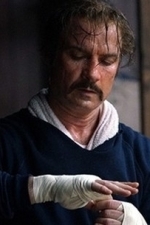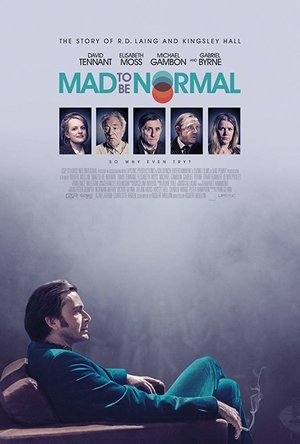Search

The Punisher - Season 1
TV Season Watch
Frank Castle, known throughout New York City as "the Punisher" after exacting revenge on those...
action

Mad Men - Season 1
TV Season
Season one takes place between March and November 1960. It introduces the fictional advertising...
Lucy Buglass (45 KP) rated Mad To Be Normal (2018) in Movies
Jun 20, 2019
Mental Health in the 60s
I’ll admit, whenever I see David Tennant’s name on a cast list I get excited. As a long time fan, I’ve watched him play a variety of roles brilliantly. So when I was given the opportunity to review Mad To Be Normal and I learned what the plot was, how could I refuse? Set in the 60s, the film follows Scottish psychiatrist R.D. Laing and his unconventional approach to mental health treatment, causing controversy within the psychiatry field.
Although I don’t know much about Laing, Tennant really shone in the central role and delivered a truly captivating character who was riddled with his own underlying issues. He’s a tricky one because sometimes you really sympathise and agree with him, but other times he’s so utterly frustrating. The film showed us many different sides to him, and created a well-rounded exploration of the man in question. He’s compassionate but also terribly naive, and that’s a dangerous combination indeed. Tennant is joined by Elisabeth Moss, Michael Gambon and Gabriel Byrne which is an excellent line up.
One of the best things about this film is the characters, because everyone does such an amazing job of portraying complex characters with equally as complex relationships. Moss plays student Angie who quickly becomes a love interest of Laing’s, and joins him in his work. Much like Laing, she is also well-rounded and has good traits and bad ones, the latter resulting in rather turbulent moments throughout the film.
I especially enjoyed the way mental health was portrayed by characters, as you could tell they were struggling and trying so hard to deal with their illnesses. It was dealt with respectfully and honestly, whilst still showing the risks of untreated mental health conditions. Gabriel Byrne in particular stands out in his portrayal of Jim, going from someone friendly and sentimental to someone violent and dangerous very quickly. It would have been good to learn more about each character and their individual backgrounds for context’s sake, replacing the unnecessary scenes with this. Nevertheless, the insight into mental health in this era was fascinating, particularly scenes involving the inhumane treatment known as electroshock therapy. It shows we have come a long way since then, but we still have a long way to go.
The stellar performances are accompanied with some great set design, which I imagine would provide some welcome nostalgia for those familiar with the era. I loved Laing’s quirky style both in his interior design, behaviour and clothing choices, making him stand out even more. He’s flamboyant in every sense of the word, but not always for the right reasons. For his time, Laing was clearly very open minded, caring and in favour of self-expression, further conflicting with the beliefs of wider society. Although open mindedness is a good thing, his goes too far which ultimately would lead to his eventual downfall.
Robert Mullan has done a great job bringing this important figure to life on screen, putting together a cast that perfectly delivered this story. Whilst I would have liked more context around both the patients and Laing himself, the film still delivered a powerful message in its 1 hour 45 minute run time. It’s definitely worth a watch.
https://lucygoestohollywood.com/2018/08/04/mental-health-in-the-60s-mad-to-be-normal-review/
Although I don’t know much about Laing, Tennant really shone in the central role and delivered a truly captivating character who was riddled with his own underlying issues. He’s a tricky one because sometimes you really sympathise and agree with him, but other times he’s so utterly frustrating. The film showed us many different sides to him, and created a well-rounded exploration of the man in question. He’s compassionate but also terribly naive, and that’s a dangerous combination indeed. Tennant is joined by Elisabeth Moss, Michael Gambon and Gabriel Byrne which is an excellent line up.
One of the best things about this film is the characters, because everyone does such an amazing job of portraying complex characters with equally as complex relationships. Moss plays student Angie who quickly becomes a love interest of Laing’s, and joins him in his work. Much like Laing, she is also well-rounded and has good traits and bad ones, the latter resulting in rather turbulent moments throughout the film.
I especially enjoyed the way mental health was portrayed by characters, as you could tell they were struggling and trying so hard to deal with their illnesses. It was dealt with respectfully and honestly, whilst still showing the risks of untreated mental health conditions. Gabriel Byrne in particular stands out in his portrayal of Jim, going from someone friendly and sentimental to someone violent and dangerous very quickly. It would have been good to learn more about each character and their individual backgrounds for context’s sake, replacing the unnecessary scenes with this. Nevertheless, the insight into mental health in this era was fascinating, particularly scenes involving the inhumane treatment known as electroshock therapy. It shows we have come a long way since then, but we still have a long way to go.
The stellar performances are accompanied with some great set design, which I imagine would provide some welcome nostalgia for those familiar with the era. I loved Laing’s quirky style both in his interior design, behaviour and clothing choices, making him stand out even more. He’s flamboyant in every sense of the word, but not always for the right reasons. For his time, Laing was clearly very open minded, caring and in favour of self-expression, further conflicting with the beliefs of wider society. Although open mindedness is a good thing, his goes too far which ultimately would lead to his eventual downfall.
Robert Mullan has done a great job bringing this important figure to life on screen, putting together a cast that perfectly delivered this story. Whilst I would have liked more context around both the patients and Laing himself, the film still delivered a powerful message in its 1 hour 45 minute run time. It’s definitely worth a watch.
https://lucygoestohollywood.com/2018/08/04/mental-health-in-the-60s-mad-to-be-normal-review/






